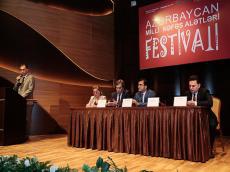|
|
TODAY.AZ / Arts & Entertainment
Festival of Traditional Wind Musical Instruments kickss off in Baku
04 October 2019 [16:16] - TODAY.AZ

By Azernews
By Laman Ismayilova
The Festival of Traditional Wind Musical Instruments started in Baku on October 3.
The festival, organized by Medeniyyet TV, opened with a scientific-practical conference on the topic "Promotion and research of Azerbaijani national wind musical instruments", Trend Life reported.
In his speech at the conference, the director of Medeniyyet TV, artistic director of the festival Ramil Gasimov stressed the festival's importance in promotion of national wind musical instruments. He emphasized that the state pays great attention to the promotion of Azerbaijan's musical art.
Ramil Gasimov said that the festival is a major event in the country's cultural life. He added that Medeniyyet TV will continue to implement similar projects in the future.
The conference participants included Rector of the Azerbaijan National Conservatory, People's Artist Siyavush Karimi, Doctor of Philosophy for Political Sciences Asif Usubaliyev, Director of the International Mugham Center, People's Artist Murad Huseynov.
The speakers noted that holding the festival will serve to shape the young generation in a national spirit
As part of the festival, various events will be held at various concert venues, including International Mugham Center, Azerbaijan National Conservatory and others. The festival, organized by by Medeniyyet TV, will run until October 6.
Azerbaijan enjoys a rich, varied musical tradition. Most of the instruments were appeared in ancient times, while most of them were improved and reached our time. Let’s see some of them.
Saz is the stringed musical instrument of the lute type. The instrument has a pear-shaped body, a neck with tied sliding frets, a wooden soundboard and double or triple strings.
Kamancha is bowed string instrument, which is widespread amongst Eastern and Central Asian peoples under a variety of names.
The folk instrument is described in the works of medieval classical poets. Mir Seyid Ali, representative of the 16th-century school of painting, depicted the barbat (lute), daf ( frame drum) and kamancheh in his work called "A Musical Gathering".
The tar, a long-necked plucked lute, is one of the most important musical instruments in Iran and the Caucasus. The tar is traditionally crafted and performed throughout Azerbaijan, and is depicted on the Azerbaijani national banknote of one manat nominal value.
Oud is a pear-shaped stringed instrument with 11 or 13 strings grouped in 5 or 6 courses. Four strings of musical instrument likened to the four elements of nature: fire, water, earth, air. It was often represented in the works of miniature painting.
Balaban is cylindrical-bore, double-reed wind instrument with seven finger holes and one thumb hole. When you play balaban you should use fingers of both hands to open and close certain holes. Balaban can be made of mulberry or other harder woods, such as walnut.
Naghara is a folk drum that is played with the bare hands. It is one of the most popular percussion instruments of the Azerbaijani folk music.
This instrument is described in the Early Middle Age Azerbaijani literary epic-"The Book of Dede Gorgud.











URL: http://www.today.az/news/entertainment/186941.html
 Print version
Print version
Connect with us. Get latest news and updates.
See Also
- 27 August 2025 [15:33]
Fourth Salam Int'l Youth Film Festival kicks off in Baku - 27 August 2025 [14:38]
Yusif Mirza's personal exhibition opens in Lachin - 27 August 2025 [10:43]
Gala concert held on occasion of Lachin City Day - 26 August 2025 [15:24]
Lachin hosts panel session on 'Youth Wave in Cultural and Creative Industries' - 26 August 2025 [14:25]
Mugham's timeless beauty highlighted in Shaki city - 26 August 2025 [12:23]
Lachin City Day to be celebrated with great splendor - 25 August 2025 [18:00]
Summer camp for young scientists held in Gazakh - 25 August 2025 [15:09]
National Library celebrates Mugham Day with fascinating exhibition - 25 August 2025 [10:44]
Archaeologists discover remains of fifth-century circular temple - 20 August 2025 [18:03]
WADF: Dance art against backdrop of Baku's modern landmarks
Most Popular
 Radicals have invented new enemy for Iran
Radicals have invented new enemy for Iran
 Research Center: Peace agreement opens historic new page for S Caucasus
Research Center: Peace agreement opens historic new page for S Caucasus
 President Ilham Aliyev receives UK Minister of State for Europe and North America
President Ilham Aliyev receives UK Minister of State for Europe and North America
 Human remains discovered in liberated A?d?r? district
Human remains discovered in liberated A?d?r? district
 ANAMA: Nearly 1,500 hectares made safe in demining push
ANAMA: Nearly 1,500 hectares made safe in demining push
 Court in Baku continues trial of Armenian-origin individuals accused of war crimes
Court in Baku continues trial of Armenian-origin individuals accused of war crimes
 Expired ammunition to be destroyed in Pir?k??kül settlement
Expired ammunition to be destroyed in Pir?k??kül settlement
